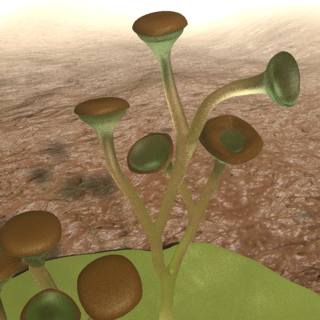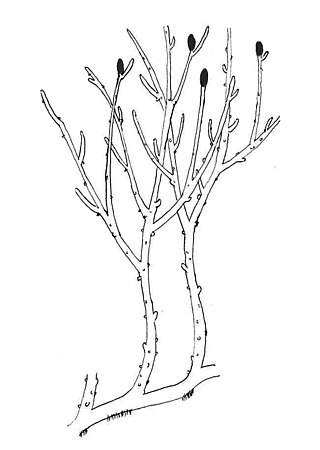
Cooksonia is an extinct group of primitive land plants, treated as a genus, although probably not monophyletic. The earliest Cooksonia date from the middle of the Silurian ; the group continued to be an important component of the flora until the end of the Early Devonian, a total time span of 433 to 393 million years ago. While Cooksonia fossils are distributed globally, most type specimens come from Britain, where they were first discovered in 1937. Cooksonia includes the oldest known plant to have a stem with vascular tissue and is thus a transitional form between the primitive non-vascular bryophytes and the vascular plants.

The rhyniophytes are a group of extinct early vascular plants that are considered to be similar to the genus Rhynia, found in the Early Devonian. Sources vary in the name and rank used for this group, some treating it as the class Rhyniopsida, others as the subdivision Rhyniophytina or the division Rhyniophyta. The first definition of the group, under the name Rhyniophytina, was by Banks, since when there have been many redefinitions, including by Banks himself. "As a result, the Rhyniophytina have slowly dissolved into a heterogeneous collection of plants ... the group contains only one species on which all authors agree: the type species Rhynia gwynne-vaughanii". When defined very broadly, the group consists of plants with dichotomously branched, naked aerial axes ("stems") with terminal spore-bearing structures (sporangia). The rhyniophytes are considered to be stem group tracheophytes.

Psilophyton is a genus of extinct vascular plants. Described in 1859, it was one of the first fossil plants to be found which was of Devonian age. Specimens have been found in northern Maine, USA; Gaspé Bay, Quebec and New Brunswick, Canada; the Czech Republic; and Yunnan, China. Plants lacked leaves or true roots; spore-forming organs or sporangia were borne on the ends of branched clusters. It is significantly more complex than some other plants of comparable age and is thought to be part of the group from within which the modern ferns and seed plants evolved.

Polysporangiophytes, also called polysporangiates or formally Polysporangiophyta, are plants in which the spore-bearing generation (sporophyte) has branching stems (axes) that bear sporangia. The name literally means 'many sporangia plant'. The clade includes all land plants (embryophytes) except for the bryophytes whose sporophytes are normally unbranched, even if a few exceptional cases occur. While the definition is independent of the presence of vascular tissue, all living polysporangiophytes also have vascular tissue, i.e., are vascular plants or tracheophytes. Extinct polysporangiophytes are known that have no vascular tissue and so are not tracheophytes.
Uskiella is a genus of small fossil plants of Early Devonian age. The diagnostic characters are naked axes branching isotomously, terminating in ellipsoidal, vertically elongate flat sporangia which split longitudinally into two valves. Spores of U. reticulata have a reticulate appearance. Coalified specimens have been reported from Wales, with a possible occurrence in Australia.

Yunia is a genus of extinct vascular plants from the Early Devonian. It was first described from the Posongchong Formation of Yunnan, China. The leafless plant consisted of spiny stems, some 2 to 5 cm wide, which branched dichotomously at wide angles in a cruciate arrangement. Each stem contained vascular tissue with one or two strands of protoxylem. The spore-forming organs (sporangia) were elongated and borne on short stalks. The spores had a relatively smooth sculptural pattern and were trilete.
Sartilmania is a genus of extinct vascular plants of the Early Devonian. Fossils were found on the Sart Tilman campus of the University of Liège, Belgium.
Hicklingia is a genus of extinct plants of the Middle Devonian. Compressed specimens were first described in 1923 from the Old Red Sandstone of Scotland. Initially the genus was placed in the "rhyniophytes", but this group is defined as having terminal sporangia, and later work showed that the sporangia of Hicklingia were lateral rather than strictly terminal, so that it is now regarded as having affinities with the zosterophylls.
Huia is a genus of extinct vascular plants of the Early Devonian. The genus was first described in 1985 based on fossil specimens from the Posongchong Formation, Wenshan district, Yunnan, China.

Adoketophyton is a genus of extinct vascular plants of the Early Devonian. The plant was first described in 1977 based on fossil specimens from the Posongchong Formation, Wenshan district, Yunnan, China. These were originally named Zosterophyllum subverticillatum; later the species was transferred to a new genus as Adoketophyton subverticillatum. One cladistic analysis suggested that it is a lycophyte, related to the zosterophylls. Other researchers regard its placement within the vascular plants as uncertain.
Junggaria was a genus of rhyniophyte-like land plants known from fossils found in China in Upper Silurian strata. It bore leafless dichotomously or pseudomonopodially branching axes, some of which ended in spore-forming organs or sporangia of complex shape. The genus Cooksonella, found in Kazakhstan from deposits of a similar age, is considered to be an illegitimate synonym.
Danziella is a genus of extinct vascular plants of the Early Devonian. Fossils found in the Artois region of northern France were first described as Zosterophyllum artesianum, but a later review by Edwards showed that they did not fit the circumscription of that genus.

Ventarura is a genus of extinct vascular plants of the Early Devonian. Fossils were found in the Windyfield chert, Rhynie, Scotland. Some features, such as bivalved sporangia borne laterally and the anatomy of the xylem, relate this genus to the zosterophylls. Other features are unclear due to poor preservation.
Trichopherophyton is a genus of extinct vascular plants of the Early Devonian. Fossils were found in the Rhynie chert, Scotland. The remains are very fragmentary, but the plant appears to be related to the zosterophylls.
Wenshania is a genus of extinct vascular plants found in the Posongchong Formation, Yunnan, China, which is of Early Devonian age. Plants consisted of leafless stems with simple dichotomous branching, and bore spore-forming organs or sporangia all around the sides of stems. Wenshania is part of the broadly defined group of zosterophylls.
Bracteophyton is a genus of extinct vascular plants of the Early Devonian comprising a single species, Bracteophyton variatum. Fossils were first found in the Xujiachong Formation of eastern Yunnan, China.
Demersatheca is a genus of extinct vascular plants of the Early Devonian. Fossils were first found in the Posongchong Formation of eastern Yunnan, China. The plant had smooth leafless stems at least 1 mm in diameter, but only regions which bore spore-forming organs or sporangia are well-known. Sporangia were borne in 'spikes' or strobili, at least 40 mm long; one had 32 sporangia. Sporangia were arranged in four rows, two sporangia being opposite to one another on the stem with the next two being at right angles. Each sporangium consisted of two 'valves' which opened at the top to release their spores. A particular feature of Demersatheca which distinguishes it from other zosterophylls is that the stalk-less sporangia were sunken into the stem of the spike, so that the outer valve was flush with the surface.
Halleophyton is a genus of extinct vascular plants of the Early Devonian. Fossils were first found in the Posongchong Formation of eastern Yunnan, China. The plant had leafy aerial stems. The leaf bases completely covered the stems forming rhomboidal to hexagonal patterns, except where spore-forming organs or sporangia were present where the leaves thinned out somewhat. The tapered undivided leaves curved inwards and appear to have had a central vein. The sporangia were mixed with leaves and were more-or-less circular in outline, consisting of two valves which split to release the spores. Halleophyton has similarities with Drepanophycus, but a lack of detailed knowledge of some features of that genus persuaded Li and Edwards to create a new genus for their specimens. Although considered to be related to the lycophytes, the exact placement of the genus was left open by its authors. Hao and Xue in 2013 listed the genus as a lycopsid.

Macivera is a genus of extinct vascular plants. Fossils were found in sediments in Bathust Island, Nunavut, Canada, from the upper Silurian. The leafless stems (axes) branched dichotomously and were relatively thin, being between 0.7 and 1.0 mm wide. Spore-forming organs or sporangia, which were elliptical, being longer than wide, were borne on the end regions of stems. Macivera is considered to be a zosterophyll.
Hollandophyton is a genus of extinct plants known from fossils found in Shropshire, England, in rocks of upper Silurian age. The specimens are fragmentary, consisting of leafless stems (axes) which branched dichotomously and bore kidney-shaped spore-forming organs or sporangia, apparently at their tips. The internal structure of the stems is unknown.








